For many product managers, improving activation is synonymous with optimizing the onboarding process. They identify key steps on the value journey of new clients, calculate user dropout rates, create hypotheses for making improvements, and start testing these hypotheses experimentally.
These changes will probably be targeted and small: tweaks to form logic, rewrites of notifications and emails, mobile-friendly design, and so on. Some teams picture activation work as being precisely this—making a large number of localized optimizations at points along the initial portions of the user journey.
Without a doubt, optimizing onboarding on the level of the product, texts, notifications, and other processes is an important part of activation work. But at some point, you need to know when it’s not enough. How do you know when to optimize with a scalpel and when to overhaul the activation process at a more fundamental level?
→ Test your product management and data skills with this free Growth Skills Assessment Test.
→ Learn data-driven product management in Simulator by GoPractice.
→ Learn growth and realize the maximum potential of your product in Product Growth Simulator.
→ Learn to apply generative AI to create products and automate processes in Generative AI for Product Managers – Mini Simulator.
→ Learn AI/ML through practice by completing four projects around the most common AI problems in AI/ML Simulator for Product Managers.
All posts of the series (24)
01. When user activation matters and you should focus on it.
02. User activation is one of the key levers for product growth.
03. The dos and don’ts of measuring activation.
04. How “aha moment” and the path to it change depending on the use case.
05. How to find “aha moment”: a qualitative plus quantitative approach.
06. How to determine the conditions necessary for the “aha moment”.
07. Time to value: an important lever for user activation growth.
08. How time to value and product complexity shape user activation.
09. Product-level building blocks for designing activation.
10. When and why to add people to the user activation process.
11. Session analysis: an important tool for designing activation.
12. CJM: from first encounter to the “aha moment”.
13. Designing activation in reverse: value first, acquisition channels last.
14. User activation starts long before sign-up.
15. Value windows: finding when users are ready to benefit from your product.
16. Why objective vs. perceived product value matters for activation.
17. Testing user activation fit for diverse use cases.
18. When to invest in optimizing user onboarding and activation.
19. Optimize user activation by reducing friction and strengthening motivation.
20. Reducing friction, strengthening user motivation: onboarding scenarios and solutions.
21. How to improve user activation by obtaining and leveraging additional user data.
When it’s (not) worth investing in optimizing user onboarding
The next few paragraphs will briefly restate what we’ve already discussed in our series of articles on activation. This information will be key for deciding whether or not it’s the right time to optimize onboarding.
To recap, the job of activation is to articulate product value to users from the target market segment. Activation mechanisms should assist the largest possible share of new users in appreciating the situations and jobs for which the product creates added value. So for making activation decisions, our foundation comes from knowing the jobs and contexts for which the product has achieved product/market fit.
Once you know where the product has product/market fit, the next step is to learn how new users with a particular job-to-be-done obtain and appreciate this value. Put another way, how do they go from “Hmm, interesting, I’ll give it a try” to “How cool! This product makes my life so much better.”
Finding the answer requires that you learn everything about the product’s perceived value and user journey: the conditions necessary for an “aha moment” to happen, the definition of “aha moment”, and knowing how the activation path and “aha moment” change based on use case.
Only then do we start building the structures that will help to surface that value to users. We study the complexity of the job and time to value, build a CJM, map the shortest path to value for every key use case, and synthesize them into a unified set of mechanisms at the level of the product, notifications, people, and other processes.
After we do all that properly, we have the foundation and walls for activation. They aren’t perfect yet, but the resulting structure will be robust and designed around the product’s value.
This is precisely the moment to start working on optimizing conversion at key steps. In other words, with the walls in place, now we can start decorating.
If we try to optimize onboarding before this point, the effect will be small because of merely aiming for local maximums. The team would be chasing improvements in a flimsy activation mechanism that is structurally unsound.
Instead, it’s much more effective to make a strong structure and design activation around product/market fit, and only then start optimizing the resulting system.
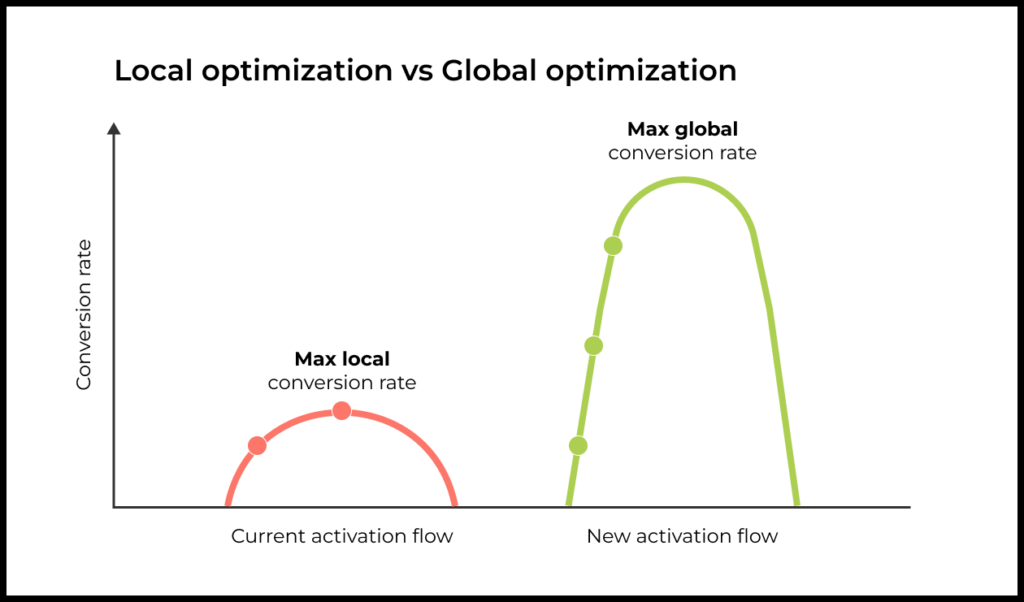
Why it’s important to invest in optimizing activation
We’ve covered when it’s worth investing more into optimization of the onboarding and activation process. But this is when many product teams will get skeptical questions like:
- Why put so much effort and resources into optimization if we can work on creating new value instead?
- The success rate for activation experiments is low. And even when an experiment succeeds, the wins are small. What’s the point of putting in so much effort?
Let’s discuss why optimization truly is important and, if done right, can give a significant competitive edge to the product and business.
Activation improvements bend the curve upwards
Improvements at the activation level actually bend the growth curve upwards for the whole business. Surfacing value more effectively leads to higher retention, which can improve monetization. This, in turn, opens up opportunities for making better use of growth channels.
Even minor improvements in activation give a helpful bump to all the key levels of the growth model simultaneously. This combined effect results in non-linear positive growth.
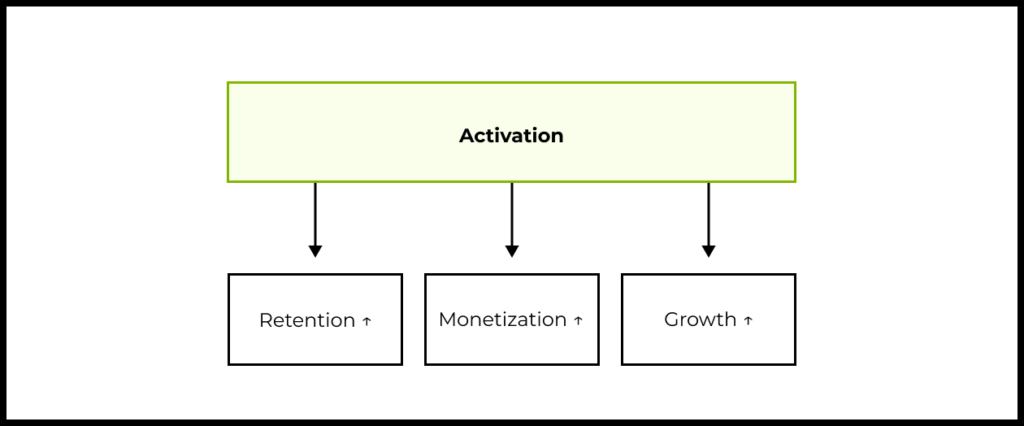
The cumulative effect of many little improvements
It’s easy to underestimate the cumulative benefit of a large number of small improvements.
Remember that your activation improvements do more than just add to each other—they actually multiply. This is important! Like compound interest, the result can seem unimpressive at first, but eventually makes a huge difference:
- 10 improvements to activation, each with an effect of 3%, have a combined effect of ~34%.
- 20 improvements to activation, each with an effect of 3% have a combined effect of 81%.
- 30 improvements to activation, each with an effect of 3%, have a combined effect of 143%.
The cumulative effect of a large number of tweaks, plus a growth curve that’s been bent upwards thanks to improved activation, can mean an enormous competitive advantage and strong boost to growth.
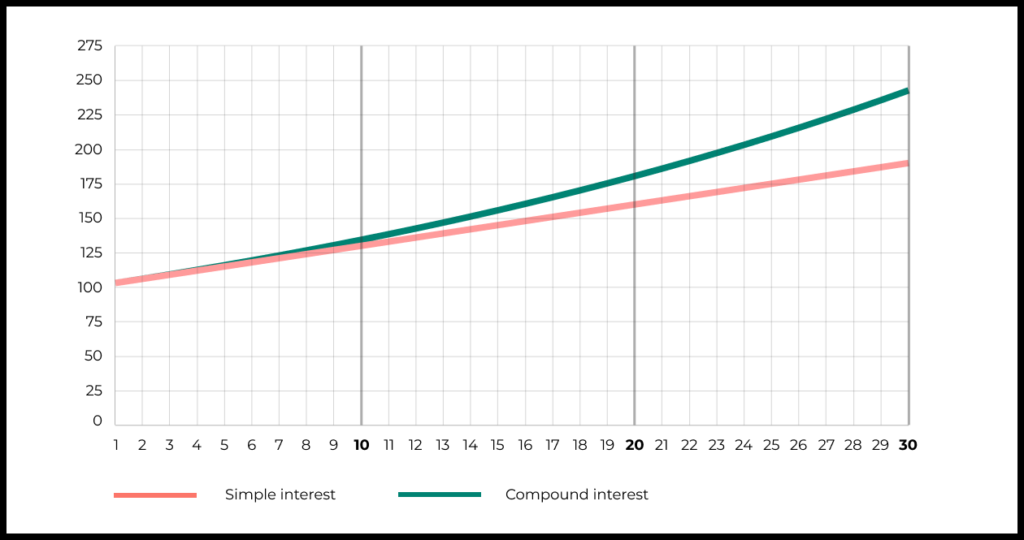
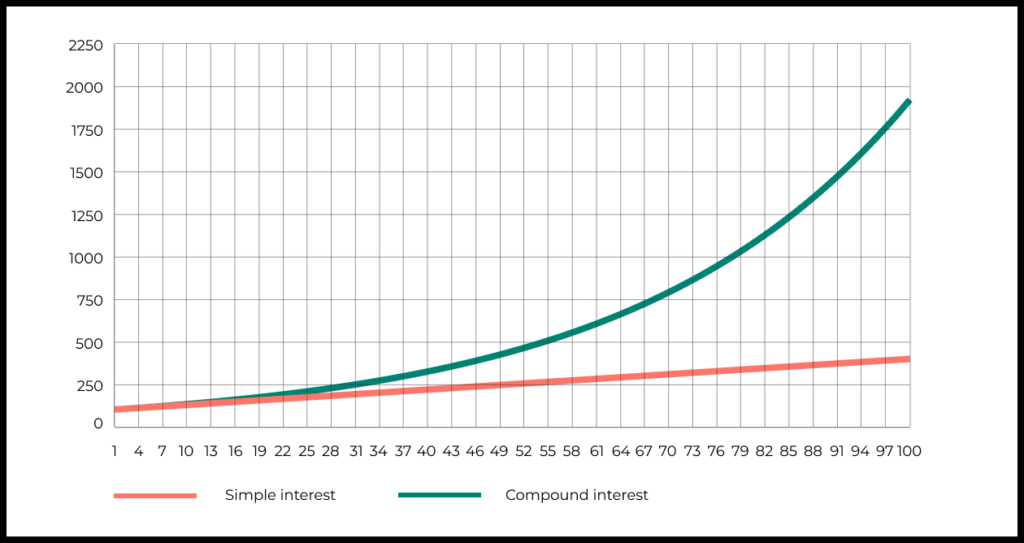
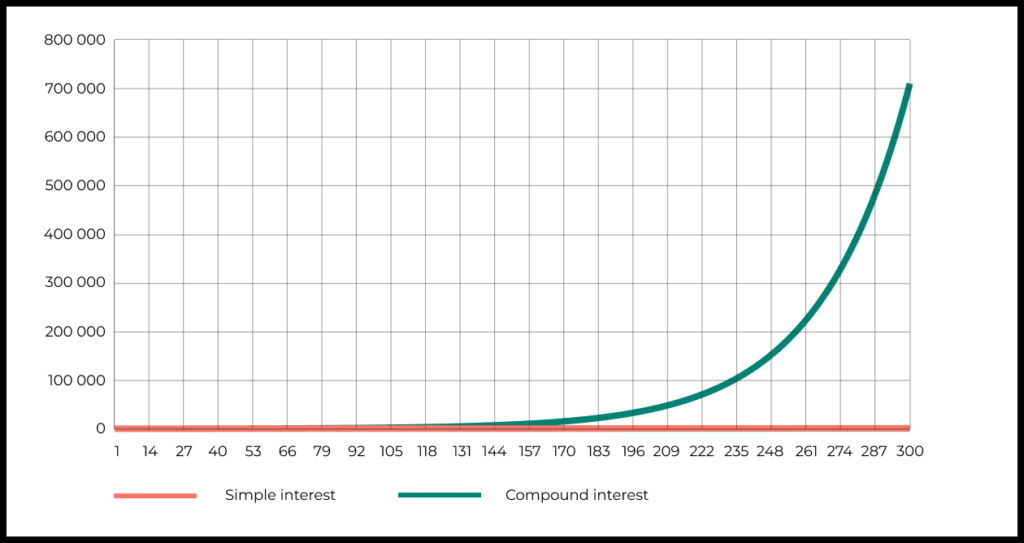
Approaches for optimizing activation
You’ve built a robust structure for surfacing your product’s value. Now it’s time to go to the next level and start making optimizations.
There are a number of approaches available for this:
- Look for methods to reduce friction and increase user motivation to persevere at each of the key steps in activation.
- Create mechanisms for engaging and winning back users who have dropped out at certain stages of activation.
- Review every screen, header, notification, and process and analyze how well it articulates product value.
- Consider possible ways of obtaining or using additional user data for simplifying or personalizing activation.
- Focus on the parts of the CJM that contribute most to the time to value. Look for ways to make it shorter.
- Analyze the order of steps in the activation process. Categorize steps by whether they provide value or require work from the user. Look for ways to reorder them or turn “tax” steps into “benefit” steps.
- Research how acquisition channels or processes outside your direct control could be impacting activation.
Equipped with an understanding of how your product creates value, how users are exposed to this value, and what product “structures” are needed for all this, you have the core knowledge needed for generating plausible hypotheses.
These hypotheses will be much more likely to produce tangible impacts than guesswork that doesn’t draw on these approaches.
Can one apply these approaches without doing all that preparation first? Of course, but the payoff will be much lower.
We will be exploring and explaining each of these approaches in subsequent articles.






